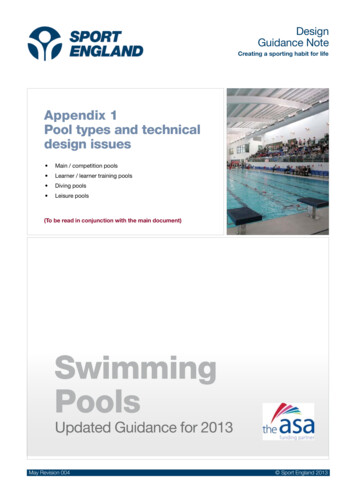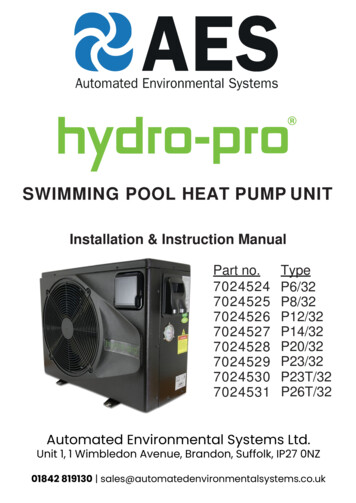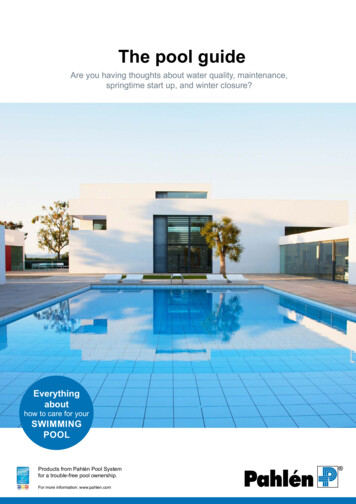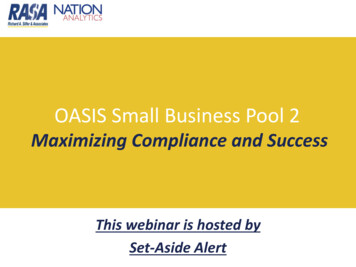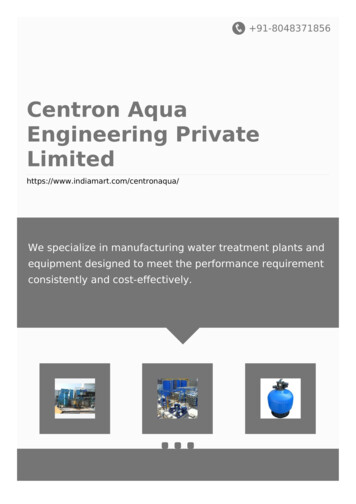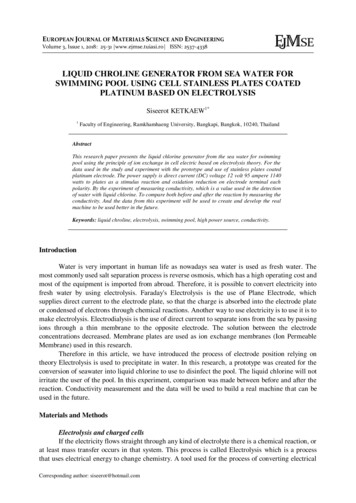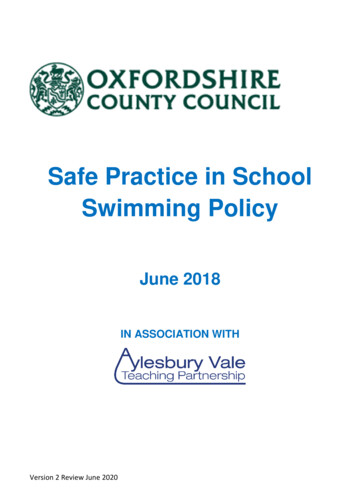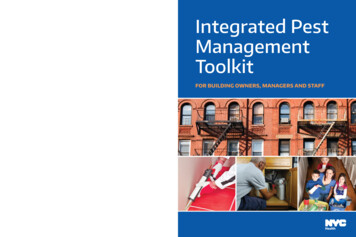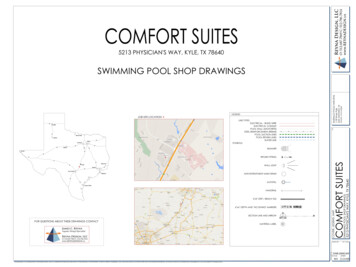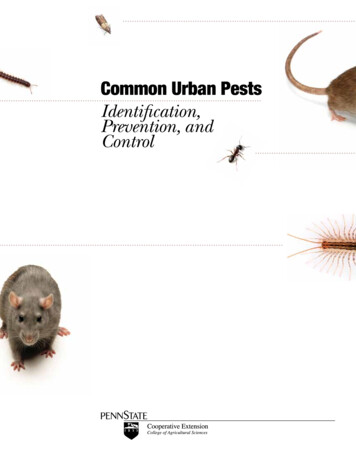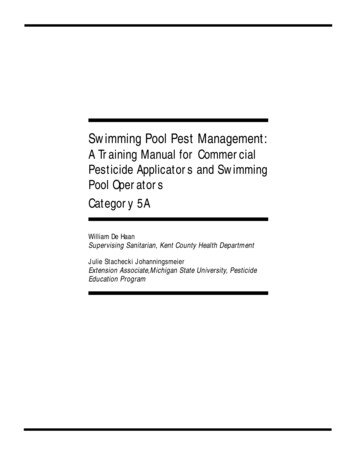
Transcription
Swimming Pool Pest Management:A Training Manual for CommercialPesticide Applicators and SwimmingPool OperatorsCategory 5AWilliam De HaanSupervising Sanitarian, Kent County Health DepartmentJulie Stachecki JohanningsmeierExtension Associate,Michigan State University, PesticideEducation Program1
PrefaceAcknowledgements and ContributorsThe maintenance and operation of public swimmingpools falls under the primary authority of the MichiganDepartment of Environmental Quality, EnvironmentalHealth Division, formerly Public Health Department. Yet,Michigan Department of Agriculture regulates the use ofpesticides, which includes some chemicals used in swimming pool maintenance. Therefore, public pool operations require that the owner and operator comply withboth departments’ rules governing the safe and lawfuloperation of swimming pools.This manual is intended to prepare pesticide applicators in category 5A, swimming pool pest management,for applicator certification under the Natural Resourcesand Environmental Protection Act, Act 451, Part 83,Pesticide Control. Read the introduction to this manual tounderstand your responsibilities for obtaining the appropriate credentials to apply pesticides safely, includingsome swimming pool chemicals, and how to use thismanual.The topics selected for this manual were formulatedon the basis of a critical collation and review of publishedreports and other pertinent data. Professional environmental health sanitarians, engineers and consultantshave contributed to this publication.The Swimming Pool/Spa Committee of the MichiganEnvironmental Health Association (M.E.H.A.) is the successor to the original committee appointed to formulateprevious technical literature.This M.E.H.A. committee consisted of the following:Ted Baran, Elwin Coll, Gil Daws, Bill DeHaan, GregFolkringa, Peggy French, John Johnson, Norm Kerr, KeithKrinn, Tom McNulty, John Ruskin, Paul Sisson and DebWerner.This manual, Swimming Pool Pest Management: ATraining Manual for Commercial Pesticide Applicators andSwimming Pool Operators was produced by Bill De Haan,environmental sanitarian for the Kent County HealthDepartment, and Michigan State University ExtensionPesticide Education programs, in conjunction with theMichigan Department of Agriculture and MichiganDepartment of Environmental Quality, EnvironmentalHealth Division. Principal participants in the projectinclude:William E. De Haan, supervising sanitarian, Kent CountyHealth Department – primary author.Julie Stachecki Johanningsmeier, Extension associate,Michigan State University Extension, Pesticide EducationProgram, second author, editor.Christina DiFonzo, pesticide education coordinator,Michigan State University Extension, Pesticide EducationProgram, technical reviewer.John Fiero, Michigan Department of EnvironmentalQuality, Environmental Health Section, Lansing, MI,technical reviewer.Mary Kolenda, Grand Rapids, MI, project development.Gil Daws, consultant, Gil Daws & Associates, Plymouth,MI, technical reviewer.We thank the National Swimming Pool Foundationfor allowing us to use portions of their Pool-Spa OperatorsHandbook for technical information and as a referencetool in preparing this manual. We also thank RutgersUniversity for sharing their Pesticide Applicator TrainingManual: Gaseous Antimicrobial Pest Control- 12A WaterSanitization, Penn State, Tom Mitchell, and Ken Dettmerwho contributed to the development of this manual.2
Table of ContentsPreface . . . . . . . . . . . . . . . . . . . . . . . . . . . . . . . . . . . . . . . . . . . . . . . . . . . . . . . . . . . . . . . . . . . . . . . . . . . . . . . . . . . . . . . . . . . . . . .Acknowledgements . . . . . . . . . . . . . . . . . . . . . . . . . . . . . . . . . . . . . . . . . . . . . . . . . . . . . . . . . . . . . . . . . . . . . . . . . . . . . . . . . . . .Table of Contents . . . . . . . . . . . . . . . . . . . . . . . . . . . . . . . . . . . . . . . . . . . . . . . . . . . . . . . . . . . . . . . . . . . . . . . . . . . . . . . . . . . . . .Introduction . . . . . . . . . . . . . . . . . . . . . . . . . . . . . . . . . . . . . . . . . . . . . . . . . . . . . . . . . . . . . . . . . . . . . . . . . . . . . . . . . . . . . . . . . . .2Chapter 1 IPM at the Pool Facility . . . . . . . . . . . . . . . . . . . . . . . . . . . . . . . . . . . . . . . . . . . . . . . . . . . . . . . . . . . . . . . . . . . .777916Pool Pests and Water Chemistry . . . . . . . . . . . . . . . . . . . . . . . . . . . . . . . . . . . . . . . . . . . . . . . . . . . . . . . . . .Integrated Pest Management (IPM) . . . . . . . . . . . . . . . . . . . . . . . . . . . . . . . . . . . . . . . . . . . . . . . . . . . . . . .Techniques Used in Pool Management . . . . . . . . . . . . . . . . . . . . . . . . . . . . . . . . . . . . . . . . . . . . . . . . . . . . .Review Questions . . . . . . . . . . . . . . . . . . . . . . . . . . . . . . . . . . . . . . . . . . . . . . . . . . . . . . . . . . . . . . . . . . . . . .235Chapter 2 Pests of Pools . . . . . . . . . . . . . . . . . . . . . . . . . . . . . . . . . . . . . . . . . . . . . . . . . . . . . . . . . . . . . . . . . . . . . . . . . . . . .13Disease Transmission . . . . . . . . . . . . . . . . . . . . . . . . . . . . . . . . . . . . . . . . . . . . . . . . . . . . . . . . . . . . . . . . . . . 13Swimming Pool Pests . . . . . . . . . . . . . . . . . . . . . . . . . . . . . . . . . . . . . . . . . . . . . . . . . . . . . . . . . . . . . . . . . . . 13Review Questions . . . . . . . . . . . . . . . . . . . . . . . . . . . . . . . . . . . . . . . . . . . . . . . . . . . . . . . . . . . . . . . . . . . . . . 17Chapter 3 Pool Disinfectants and pH . . . . . . . . . . . . . . . . . . . . . . . . . . . . . . . . . . . . . . . . . . . . . . . . . . . . . . . . . . . . . . . . .Chlorine-Based Pool Disinfectants . . . . . . . . . . . . . . . . . . . . . . . . . . . . . . . . . . . . . . . . . . . . . . . . . . . . . . . .Bromine-Based Pool Disinfectants . . . . . . . . . . . . . . . . . . . . . . . . . . . . . . . . . . . . . . . . . . . . . . . . . . . . . . . . .Other Types of Sanitizers or Oxidizers . . . . . . . . . . . . . . . . . . . . . . . . . . . . . . . . . . . . . . . . . . . . . . . . . . . . .pH . . . . . . . . . . . . . . . . . . . . . . . . . . . . . . . . . . . . . . . . . . . . . . . . . . . . . . . . . . . . . . . . . . . . . . . . . . . . . . . . . .Review Questions . . . . . . . . . . . . . . . . . . . . . . . . . . . . . . . . . . . . . . . . . . . . . . . . . . . . . . . . . . . . . . . . . . . . . .Chapter 4 Pool Water Testing . . . . . . . . . . . . . . . . . . . . . . . . . . . . . . . . . . . . . . . . . . . . . . . . . . . . . . . . . . . . . . . . . . . . . . . .Testing for Chlorine . . . . . . . . . . . . . . . . . . . . . . . . . . . . . . . . . . . . . . . . . . . . . . . . . . . . . . . . . . . . . . . . . . . .Testing pH . . . . . . . . . . . . . . . . . . . . . . . . . . . . . . . . . . . . . . . . . . . . . . . . . . . . . . . . . . . . . . . . . . . . . . . . . . . .Testing for Calcium Hardness Levels . . . . . . . . . . . . . . . . . . . . . . . . . . . . . . . . . . . . . . . . . . . . . . . . . . . . . .Testing for Total Alkalinity . . . . . . . . . . . . . . . . . . . . . . . . . . . . . . . . . . . . . . . . . . . . . . . . . . . . . . . . . . . . . . .Total Dissolved Solids (TDS) . . . . . . . . . . . . . . . . . . . . . . . . . . . . . . . . . . . . . . . . . . . . . . . . . . . . . . . . . . . . .Cyanuric Acid Testing . . . . . . . . . . . . . . . . . . . . . . . . . . . . . . . . . . . . . . . . . . . . . . . . . . . . . . . . . . . . . . . . . .Copper Testing . . . . . . . . . . . . . . . . . . . . . . . . . . . . . . . . . . . . . . . . . . . . . . . . . . . . . . . . . . . . . . . . . . . . . . . .Iron Testing . . . . . . . . . . . . . . . . . . . . . . . . . . . . . . . . . . . . . . . . . . . . . . . . . . . . . . . . . . . . . . . . . . . . . . . . . . .Test Strips for Water Chemistry Levels . . . . . . . . . . . . . . . . . . . . . . . . . . . . . . . . . . . . . . . . . . . . . . . . . . . . .Record Keeping . . . . . . . . . . . . . . . . . . . . . . . . . . . . . . . . . . . . . . . . . . . . . . . . . . . . . . . . . . . . . . . . . . . . . . . .Summary for Water Chemistry Parameter Testing . . . . . . . . . . . . . . . . . . . . . . . . . . . . . . . . . . . . . . . . . . .Review Questions . . . . . . . . . . . . . . . . . . . . . . . . . . . . . . . . . . . . . . . . . . . . . . . . . . . . . . . . . . . . . . . . . . . . . .Chapter 5 Bacteriological Analysis of Pool Water.Purpose . . . . . . . . . . . . . . . . . . . . . . . . . . . . . . . . . . . . . . . . . . . . . . . . . . . . . . . . . . . . . . . . . . . . . . . . . . . . . .Standards . . . . . . . . . . . . . . . . . . . . . . . . . . . . . . . . . . . . . . . . . . . . . . . . . . . . . . . . . . . . . . . . . . . . . . . . . . . . .Frequency and Timing of Sampling . . . . . . . . . . . . . . . . . . . . . . . . . . . . . . . . . . . . . . . . . . . . . . . . . . . . . . .Collection Procedures . . . . . . . . . . . . . . . . . . . . . . . . . . . . . . . . . . . . . . . . . . . . . . . . . . . . . . . . . . . . . . . . . . .Related Data . . . . . . . . . . . . . . . . . . . . . . . . . . . . . . . . . . . . . . . . . . . . . . . . . . . . . . . . . . . . . . . . . . . . . . . . . .Transportation and Storage . . . . . . . . . . . . . . . . . . . . . . . . . . . . . . . . . . . . . . . . . . . . . . . . . . . . . . . . . . . . . .Interpretation of Sample Data . . . . . . . . . . . . . . . . . . . . . . . . . . . . . . . . . . . . . . . . . . . . . . . . . . . . . . . . . . . .Review Questions . . . . . . . . . . . . . . . . . . . . . . . . . . . . . . . . . . . . . . . . . . . . . . . . . . . . . . . . . . . . . . . . . . . . . 34353536
Chapter 6 Water Chemistry and Pool Water Balance . . . . . . . . . . . . . . . . . . . . . . . . . . . . . . . . . . . . . . . . . . . . . . . .37Langelier Saturation Index . . . . . . . . . . . . . . . . . . . . . . . . . . . . . . . . . . . . . . . . . . . . . . . . . . . . . . . . . . . . . . . 37Parameters for Saturation Index . . . . . . . . . . . . . . . . . . . . . . . . . . . . . . . . . . . . . . . . . . . . . . . . . . . . . . . . . . 37Review Questions . . . . . . . . . . . . . . . . . . . . . . . . . . . . . . . . . . . . . . . . . . . . . . . . . . . . . . . . . . . . . . . . . . . . . . 42Chapter 7 Chlorination of Pool Water . . . . . . . . . . . . . . . . . . . . . . . . . . . . . . . . . . . . . . . . . . . . . . . . . . . . . . . . . . . .Chlorine Demand . . . . . . . . . . . . . . . . . . . . . . . . . . . . . . . . . . . . . . . . . . . . . . . . . . . . . . . . . . . . . . . . . . . . . .Chlorine as Hypochlorous Acid (HOCI) and Hydrochloric Acid (HCI) . . . . . . . . . . . . . . . . . . . . . . . . . .Factors Affecting Chlorine Efficiency . . . . . . . . . . . . . . . . . . . . . . . . . . . . . . . . . . . . . . . . . . . . . . . . . . . . . .Superchlorination . . . . . . . . . . . . . . . . . . . . . . . . . . . . . . . . . . . . . . . . . . . . . . . . . . . . . . . . . . . . . . . . . . . . . .Chlorination Summary . . . . . . . . . . . . . . . . . . . . . . . . . . . . . . . . . . . . . . . . . . . . . . . . . . . . . . . . . . . . . . . . . .Review Questions . . . . . . . . . . . . . . . . . . . . . . . . . . . . . . . . . . . . . . . . . . . . . . . . . . . . . . . . . . . . . . . . . . . . . .Chapter 8 Recirculation and Filtration Systems . . . . . . . . . . . . . . . . . . . . . . . . . . . . . . . . . . . . . . . . . . . . . . . . . . . . . .Calculating Area of Pools . . . . . . . . . . . . . . . . . . . . . . . . . . . . . . . . . . . . . . . . . . . . . . . . . . . . . . . . . . . . . . . .Calculating Volume of Pools . . . . . . . . . . . . . . . . . . . . . . . . . . . . . . . . . . . . . . . . . . . . . . . . . . . . . . . . . . . . .Pool Filter Systems and Operation . . . . . . . . . . . . . . . . . . . . . . . . . . . . . . . . . . . . . . . . . . . . . . . . . . . . . . . .Review Questions . . . . . . . . . . . . . . . . . . . . . . . . . . . . . . . . . . . . . . . . . . . . . . . . . . . . . . . . . . . . . . . . . . . . . .434343434445464747484952Chapter 9 Cartridge and Diatomaceous Earth (D.E.) Filters.Cartridge Filters . . . . . . . . . . . . . . . . . . . . . . . . . . . . . . . . . . . . . . . . . . . . . . . . . . . . . . . . . . . . . . . . . . . . . . .Diatomaceous Filters . . . . . . . . . . . . . . . . . . . . . . . . . . . . . . . . . . . . . . . . . . . . . . . . . . . . . . . . . . . . . . . . . . .Review Questions . . . . . . . . . . . . . . . . . . . . . . . . . . . . . . . . . . . . . . . . . . . . . . . . . . . . . . . . . . . . . . . . . . . . . .53535456Chapter 10 Wading Pool Maintenance . . . . . . . . . . . . . . . . . . . . . . . . . . . . . . . . . . . . . . . . . . . . . . . . . . . . . . . . . . . . . . . . .Enclosures . . . . . . . . . . . . . . . . . . . . . . . . . . . . . . . . . . . . . . . . . . . . . . . . . . . . . . . . . . . . . . . . . . . . . . . . . . . .Water Circulation and Flow Rate . . . . . . . . . . . . . . . . . . . . . . . . . . . . . . . . . . . . . . . . . . . . . . . . . . . . . . . . .Disinfecting Wading Pool Water . . . . . . . . . . . . . . . . . . . . . . . . . . . . . . . . . . . . . . . . . . . . . . . . . . . . . . . . . .Testing the Water and Operational Reports . . . . . . . . . . . . . . . . . . . . . . . . . . . . . . . . . . . . . . . . . . . . . . . . .Contamination of Wading Pool Water . . . . . . . . . . . . . . . . . . . . . . . . . . . . . . . . . . . . . . . . . . . . . . . . . . . . .General Maintenance . . . . . . . . . . . . . . . . . . . . . . . . . . . . . . . . . . . . . . . . . . . . . . . . . . . . . . . . . . . . . . . . . . .Supervision . . . . . . . . . . . . . . . . . . . . . . . . . . . . . . . . . . . . . . . . . . . . . . . . . . . . . . . . . . . . . . . . . . . . . . . . . . .Review Questions . . . . . . . . . . . . . . . . . . . . . . . . . . . . . . . . . . . . . . . . . . . . . . . . . . . . . . . . . . . . . . . . . . . . . .575757575757585859.60Answers to Review Questions. . . . . . . . . . . . . . . . . . . . . . . . . . . . . . . . . . . . . . . . . . . . . . . . . . . . . . . . . . . . . . . . . . . . . . . . .65Appendixes:69697276818385878892Glossary.A: Opening and Winterizing Pools . . . . . . . . . . . . . . . . . . . . . . . . . . . . . . . . . . . . . . . . . . . . . . . . . . . . . . . . . . .B: Troubleshooting for Pools . . . . . . . . . . . . . . . . . . . . . . . . . . . . . . . . . . . . . . . . . . . . . . . . . . . . . . . . . . . . . . . .C: Pool Safety . . . . . . . . . . . . . . . . . . . . . . . . . . . . . . . . . . . . . . . . . . . . . . . . . . . . . . . . . . . . . . . . . . . . . . . . . . . . . .D: Spinal Injuries . . . . . . . . . . . . . . . . . . . . . . . . . . . . . . . . . . . . . . . . . . . . . . . . . . . . . . . . . . . . . . . . . . . . . . . . . .E: Supervisory Pool personnel . . . . . . . . . . . . . . . . . . . . . . . . . . . . . . . . . . . . . . . . . . . . . . . . . . . . . . . . . . . . . .F: Pool Operation Report. . . . . . . . . . . . . . . . . . . . . . . . . . . . . . . . . . . . . . . . . . . . . . . . . . . . . . . . . . . . . . . . . . . .G: Pool Inspection Forms . . . . . . . . . . . . . . . . . . . . . . . . . . . . . . . . . . . . . . . . . . . . . . . . . . . . . . . . . . . . . . . . . . . .H: Convenient Conversion Factors . . . . . . . . . . . . . . . . . . . . . . . . . . . . . . . . . . . . . . . . . . . . . . . . . . . . . . . . . . .I: Michigan Department of Agriculture Pesticide and Plant Pest Management Division.J: Michigan Department of Environmental Quality, Drinking Water and radiological ProtectionDivision, Evironmental Health Section-Swimming Pool Specialists . . . . . . . . . . . . . . . . . . . . . . . . . .K: Operational Guidelines (Provided by MDPH. This section supplements the information found inthe text/other chapters of this manual and is an outline of some of the information found in the .Swimming Pool Rules of Act 368.) . . . . . . . . . . . . . . . . . . . . . . . . . . . . . . . . . . . . . . . . . . . . . . . . . . . . . . . . . .L: Public Swimming Pools Act 368 of the Public Acts of 1978 and rules . . . . . . . . . . . . . . . . . . . . . . . . .Pesticide Emergency Information (AM-37) . . . . . . . . . . . . . . . . . . . . . . . . . . . . . . . . . . . . . . . . . . . . . . . . . . . .4939497114
Introductionchapter. It also explains the standards of knowledgerequired of registered technicians and commercial applicators for Category 5A, swimming pool pest management.Why Should Pesticide Applicators be Certified orRegistered?Recertification for Certified CommercialApplicatorsPesticides are used to protect food and non-food crops,people, homes, swimming pools, animals, and variousindustrial processes. To best protect human health and theenvironment by assuring the safe use and application ofpesticides, the Michigan Department of Agriculture(MDA) administers the certification and registration program for pesticide applicators. Certification or registrationrequires obtaining the knowledge necessary to purchaseand safely use pesticides. Because some of the chemicalsused in pool maintenance and operations are pesticidesthis requires persons who handle and apply them to becertified or registered pesticide applicators. The followingsections explain who must be certified or registered.Similar to a Michigan driver’s license, applicators arerequired to be recertified every three years. You can berecertified by one of two methods. With one method, youcan request from the MDA to take a recertification examthat shows a sustained level of knowledge in proper pesticide use. Study manuals are available from MSU. Withanother method, you can attend approved seminars orworkshops relating to swimming pool pest managementand accumulate credits over the three-year period to satisfy the recertification requirements for category 5A. Forspecific information on recertification, contact your localMDA regional office.Certification/Registration RequirementsRegistered TechniciansThe Natural Resources and Environmental ProtectionAct, Act 451, Part 83, Pesticide Control, requires any person who applies a pesticide product for a commercial purpose, or applies any pesticide in the course of his or heremployment, or other business activity for any purposeother than a private agricultural purpose, to be either acommercially certified applicator or a registered technician. Exempt from the certification and registered technician requirements are those pesticide operations notrequired to be licensed by the Act and those applicatorsusing general-use, ready-to-use pesticide products. Forexample, a person who works at a hospital, school, factory, golf course or an apartment complex that uses only ageneral use, ready-to-use pesticide products is notrequired to be a certified applicator or a registered technician. For more information, read the laws and regulationschapter of the Pesticide Applicator Core Training Manual(E-2195) or contact your local MDA office (see appendix I).To become a registered technician in Category 5A, youmust successfully pass an exam based on Part A of thePesticide Applicator Core Training Manual (E-2195) andparticipate in an approved training program specific topool pest management. To receive a registered technicianapplication form, contact your local MDA regional office.Registered technician status is valid for three years. Atthe conclusion of the three-year registration period, thetechnician may renew the registered technician credentialby examination and refresher training, or by accumulating a specific number of reregistration credits. Creditstoward reregistration are earned by attending approvedworkshops and seminars during the three-year registration period. A registered technician also may choose tofulfill the requirements for becoming a certified commercial pesticide applicator instead of the registered technician credential.Certification of Commercial ApplicatorsSuggestions for Studying This ManualTo become certified as a commercial applicator inSwimming Pool Pest Management (Category 5A) inMichigan, you are required to successfully complete awritten exam on the Core manual information from PartA (E-2195) and an exam on information found in thismanual. Information found in the appendices is not covered on the MDA exams. Exam questions are based oninformation provided in this training manual developedby Michigan State University Extension (MSUE),Michigan Department of Agriculture (MDA), theMichigan Department of Environmental Quality(MDEQ), and environmental sanitarians working in theswimming pool management industry.This manual presents basic water chemistry parameters, pest management and pesticide handling informationfor persons managing bacteria, fungi, algae or viruses inswimming pools, hot tubs, and spas and wading pools.This manual is self-teaching and contains learningobjectives and review questions at the end of eachThe ten chapters in this manual are designed to assistcommercial applicators to meet registered technician orcertification requirements. You may already know someof the material from your experience with pesticides.Self-help questions are included at the end of each chapter, but they are not necessarily the questions on the certification exam. If you have problems using the manual,please consult your county Extension agent, your supervisor or a representative of the MDA for help.The following are suggestions for studying this manual:1. Find a place and time for study where you will notbe disturbed.2. Read the entire manual once to understand thescope and the manner in which the material is presented. A glossary at the back of the manual definessome of the terms used in the chapters.3. Study one chapter at a time. Read the learning objectives to determine what critical information should5
5. When you have finished studying all of its sections,reread the entire manual once again. Review anysections that you feel you do not fully understand.This manual is intended to help you use pesticideseffectively and safely when they are needed. Review itoccasionally to keep the material fresh in your mind.be obtained from the chapter. Underline importantpoints or take written notes as you study the chapter.4. Answer, in writing, the review questions at the endof each chapter. Review the learning objectives andconfirm that you have grasped the critical pointsfrom the text. These learning objectives and questions are intended to help you study and evaluateyour knowledge of the subject.6
CHAPTER1IPM AT THE POOL FACILITYpest levels, and the bathers’ comfort and safety. Waterparameters that must be managed include: Organic content, pH, Total alkalinity, Calcium hardness, Temperature, Concentration of available disinfectant, and Total dissolved solids.LEARNING OBJECTIVESAfter completely studying this chapter, you should beable to: Explain the term integrated pest management (IPM). List pests that can live in pools. Name the water chemistry parameters that must bemanaged. Identify the sources of contaminants in pool water.Pests may invade and deteriorate the quality of anyenvironment. Microbial pests that can be introduced inpool environments include: Algae, Bacteria, Fungi, and Viruses. Monitor pool environments. Explain various pool pest management control tactics. Explain the role of pool sampling and testing in pestand water quality management.Just as water chemistry influences pest levels, pest levels can influence water chemistry. Furthermore, if notcontrolled, microbial pests can damage equipment or create unsafe and unhealthy conditions for pool users.Pool Pests and Water ChemistrySwimming pools and spas should be clear, sparklingbodies of water that provide recreation, fun and relaxation. These bodies of water require specific managementand regular maintenance to keep them clean and safe.The pool owner/operator also has certain legal liabilitiesfor pool safety.Managing a swimming pool or spa requires knowledge about the types of pests that may be found in a poolenvironment, as well as a technical understanding of thewater chemistry.A technical understanding and constant maintenanceof the water chemistry is essential for maintaining a safeand clean pool or spa. Water chemistry levels influenceIntegrated Pest Management (IPM)To manage water chemistry and control the pests thatinterfere with pool and spa systems, we can use a management system known as integrated pest management (IPM).IPM is the use of all available tactics or strategies to managepests so that, in this discussion, acceptable pool and poolfacility quality can be achieved economically with the leastdisruption to the environment. This acronym also worksnicely to represent integrated pool management (IPM).IPM allows us to use all the information about an aquatic7IPM at the Pool Facility
environment to keep pests in check and water chemistrybalanced. When one part of this aquatic managementpuzzle—pests or chemistry—gets out of control, there islikely to be problems with the other.Understanding the characteristics of the water systemyou manage and the pests associated with it, includingtheir identification, life cycles, and density, is essential toa successful IPM program. Employing an IPM programallows you to methodically gather site and system information, make informed decisions, select and implementcontrol measures, and evaluate and record the results.To measure levels of disinfectants, including free available chlorine (F.A.C.), total available chlorine (T.A.C.)and combined available chlorine (C.A.C.), the D.P.D.(diethyl-p-phenylenediamine) test kit is recognized bythe Michigan Department of Environmental Quality(MDEQ) as reliable if performed correctly.Bacteriological analysis of swimming pool waterdetermines the sanitary quality and suitability for publicuse. Pool water can become highly contaminated or polluted, at least momentarily, from the swimmers in it.Michigan's rules for public pools require the collectionand bacteriological analysis of water samples once aweek, or more often under unusual conditions as directed by the state or local health department. The frequencyof sampling may vary with such factors as the amount ofpool use, especially if the pool is heavily used. If possible,collect samples for bacterial analysis when swimmers arein the pool, preferably during periods of peak use. Sincethe maximum amount of contamination exists withinapproximately the first five minutes after swimmers haveentered the water, it is ideal if samples are collected within this period. If the water quality under such extremeconditions is satisfactory, it is reasonably correct to statethe water quality is satisfactory at other times when thebather use is less.Monitoring and SamplingMonitoring aquatic environments is a continuous joband involves using testing kits as well as your senses.Watching the color and clarity of the water are indications of water characteristics and signs of pest development. Pests may not be obvious in the morning but maybe detectable later the same day. The pool’s odor can bean indicator of whether the water parameters are balanced or not. By monitoring the pool users, (for exampleasking swimmers about eye irritation) an operator can bealerted to water quality problems. Monitoring the activity and cleanliness of the pool users also provides indicators of the water’s chemical needs, especially when poolsare crowded or many bathers are using tanning lotionsand oils. Monitoring and requiring bathers to showerbefore using the pool are factors in overall pool watermanagement. Keeping track of the sanitary condition ofpool facilities and buildings also factors into the potentialfor pool water contamination.Specific Identification of Pests andChemical ImbalancesOnce the pool operator determines there is an upset inthe chemical balance of the water—it is turbid, smellsstrongly of the disinfectant, or possibly there is a contaminate in the water—the cause of the poor water qualitymust be identified. Determining which water parametersare outside of an acceptable range and using anothertool—the Langelier saturation index—provides the operatorwith information needed to balance the pool water. (Theuse of the Langelier saturation index is discussed in chapter 6, Water Chemistry and Pool Water Balance.) Further,the levels of disinfectant must be evaluated continuallyand adjusted according to current conditions. Correctlyidentifying a type of algae aids in the selection of the bestcontrol tactic. Also, the level and frequency of detectingcontaminants gives the operator information for adjustingmanagement practices to ensure public safety.Monitoring water chemistry parameters requires aperceptive sense of smell and use of visual indicatorssuch as turbidity. However, to specifically identify achemical imbalance requires measurements with testingequipment. For instance, specific test kits are used todetermine the disinfectant levels, pH of water, total alkalinity, total hardness, total dissolved solids (TDS), andcopper and iron levels. The test kits must have freshreagents and be kept clean to provide reliable results. Theuse of these kits is discussed in more detail in chapter 4.IPM at the Pool FacilityThe pool operator must know how much water is inthe pool and have a working knowledge of the pool’srecirculatio
Explain the term integrated pest management (IPM). List pests that can live in pools. Name the water chemistry parameters that must be managed. Identify the sources of contaminants in pool water. Monitor pool environments. Explain various pool pest management control tactics. Explain the role of pool sampling and testing in pest
